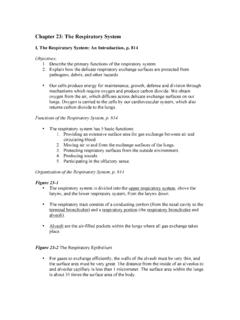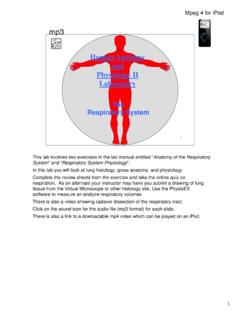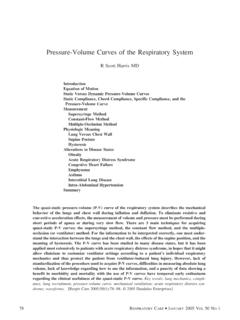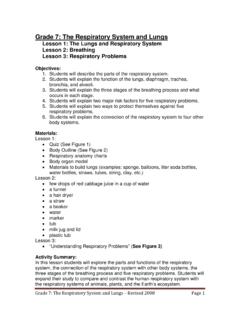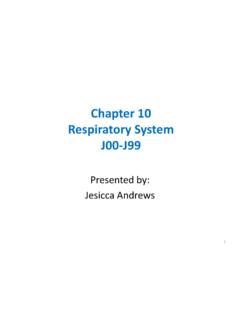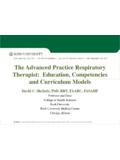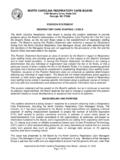Transcription of CHRONIC RESPIRATORY DISEASES - WHO
1 12 CHRONIC RESPIRATORY DISEASESCHRONIC RESPIRATORY DISEASES4. CHRONIC disease EpidemicsKEY MESSAGESC hronic disease epidemics take decades to become fully DISEASES often begin in childhood. Because of their slow evolution and CHRONIC nature, CHRONIC DISEASES present opportunities for prevention. Many different CHRONIC DISEASES may occur in the same patient ( CHRONIC RESPIRATORY DISEASES , cardiovascular disease and cancer). The treatment of CHRONIC DISEASES demands a long-term and systematic for patients with CHRONIC DISEASES should be an integral part of the activities of health services, alongside care for patients with acute and infectious DISEASES .
2 CHRONIC RESPIRATORY DISEASES are a group of CHRONIC DISEASES affecting the airways and the other structures of the lungs. Common CHRONIC RESPIRATORY DISEASES are listed in Table 2, as they appear in ICD-10. Common symptoms of the RESPIRATORY tract are also listed in ICD-10 (Table 3).DiseasesInternational Classifi cation of DISEASES (ICD-10)Asthma J44a 46 Bronchiectasis A15 16b, J44, J47, Q32 33 CHRONIC obstructive lung disease , including CHRONIC obstructive pulmonary disease , bronchitis and emphysemaJ40 44 CHRONIC rhinosinusitisJ32 33 Hypersensitivity pneumonitis J66 67 Lung cancer and neoplasms of RESPIRATORY and intrathoracic organsC30 39 Lung fi brosisB90, J69, J70, J84, P27 Table 2 Common CHRONIC RESPIRATORY diseasesCONTINUED ON NEXT PAGE13 Hundreds of millions of people around the world suffer from preventable CHRONIC RESPIRATORY DISEASES .
3 The prevalence estimates shown in Table 4 are likely to be conservative. This report focuses on the following preventable CHRONIC RESPIRATORY DISEASES and their risk factors:Asthma and RESPIRATORY obstructive pulmonary disease (COPD). DiseasesInternational Classifi cation of DISEASES (ICD-10) CHRONIC pleural DISEASES C38, C45, D38, J92 PneumoconiosisJ60 65 Pulmonary eosinophiliaJ82 Pulmonary heart disease and DISEASES of pulmonary circulation including pulmonary embolism, pulmonary hypertension and cor pulmonaleI26 28 RhinitisJ30 31, J45 aSarcoidosisD86 Sleep apnea syndrome G47a Codes depicted are not exclusive of the disease listed.
4 All codes mentioning the specifi c DISEASES were included. b In patients with tuberculosis. Source: reference 2 (CONTINUED) RESPIRATORY symptomsInternational Classifi cation of DISEASES (ICD-10)Haemorrhage from RESPIRATORY passagesEpistaxisHaemoptysis CoughR05 Abnormalities of breathingDyspnoeaStridorWheezingHyperven tilationSneezing Pain in the throat and chestR07 Other symptoms and signs involving the circulatory and RESPIRATORY systemsAsphyxiaPleurisyRespiratory arrest (cardiorespiratory failure)Abnormal sputum Source: reference 3 Symptoms and signs involving the RESPIRATORY system14 CHRONIC RESPIRATORY DISEASESO ccupational lung apnea symptoms are among the major causes of consultation at primary health care centres.
5 Surveys in nine countries, in 76 primary health care facilities, among which 54 ( ) involved medical offi cers and 22 ( ) nurses only. The number of primary health care facilities, involving 29 399 RESPIRATORY patients, showed that the proportion of patients with RESPIRATORY symptoms, among those over 5 years of age, who visited primary health care centres ranged from to (Table 5). CHRONIC RESPIRATORY diseaseYear of estimationPrevalenceReferenceAsthma20043 00 million15 CHRONIC obstructive pulmonary disease2000210 million30 32 Allergic rhinitis1996 2006400 million33 37 Other RESPIRATORY diseases2006>50 million38 44 Sleep apnea syndrome1986 2002>100 million45 48 Table 4 Estimates of the prevalence of preventable CHRONIC RESPIRATORY (1st survey) (2nd survey) : reference 5 Proportion of patients with RESPIRATORY symptoms among all patients (aged 5 years and older) who visited primary health care facilities for any reason155.
6 AsthmaKEY MESSAGES 300 million people of all ages worldwide have prevalence of asthma has increased following changes to a modern, urban lifestyle. Globally, 250 000 people die of asthma every year. Asthma deaths are related to lack of proper for asthma is not available to all people who have asthma. Asthma is a CHRONIC infl ammatory disorder of the airways, usually associated with airway hyper-responsiveness and variable airfl ow obstruction, that is often reversible spontaneously or under treatment (50). Allergen sensitization is an important risk factor for asthma.
7 Asthma is often associated with rhinitis, an infl ammation of the nasal mucosa (51).PrevalenceAsthma affects both children and adults. Using a conservative defi nition, it is estimated that as many as 300 million people of all ages and all ethnic backgrounds suffer from asthma. Two large multinational studies have assessed the prevalence of asthma around the world: the European Community RESPIRATORY Health Survey (ECRHS) in adults (52) and the International Study of Asthma and Allergies in Childhood (ISAAC) in children (33).
8 The world map of the prevalence of asthma (Figure 4) is based on these two studies (15). Trends in asthma prevalence vary between countries. For the past 40 years, the prevalence of asthma has increased in all countries in parallel with that of allergy. Asthma is still increasing worldwide as communities adopt modern 4 World map of the prevalence of clinical asthmaProportion of population (%)Source: reference standardized data available16 CHRONIC RESPIRATORY DISEASES lifestyles and become urbanized (13, 53, 54). With a projected increase in the proportion of the world s population living in urban areas, there is likely to be a marked increase in the number of people with asthma worldwide over the next two decades.
9 It is estimated that there may be an additional 100 million people with asthma by 2025 (15). However, the prevalence of asthma and allergy may decrease in children in some countries with a high prevalence of the disease and the increase in the asthma epidemic may come to an end in some countries (55 57).MortalityIt is estimated that asthma accounts for about 250 000 annual deaths worldwide. There are large differences between countries, and the rate of asthma deaths does not parallel prevalence (Figure 5). Mortality seems to be high in countries where access to essential drugs is of the deaths are preventable, being a result of suboptimal long-term medical care and delay in obtaining help during the fi nal attack.
10 In many areas of the world, people with asthma do not have access to basic asthma medications and health care (15) (Figure 6). The countries with the highest death rates are those in which controller therapy is not available. In many countries, deaths due to asthma have declined recently as a result of better asthma management (58).MorbidityThe hospitalization of patients with asthma is another measure of asthma severity, but data cannot be obtained in most low and middle income countries (59). In countries or regions where asthma management plans have been implemented, hospitalization rates have decreased (58, 60).










